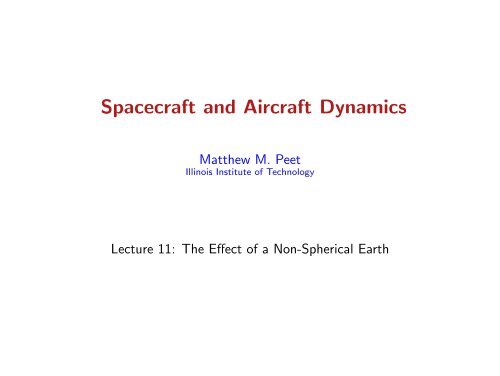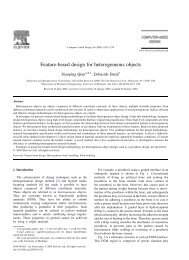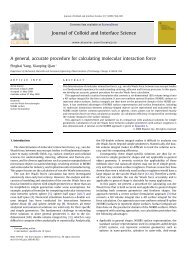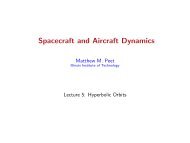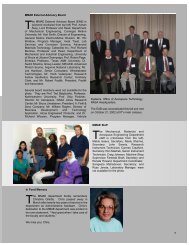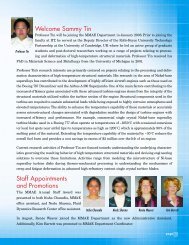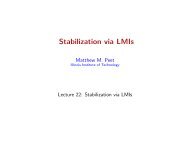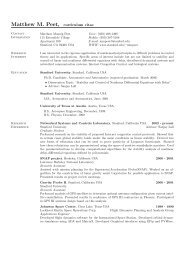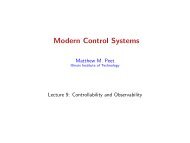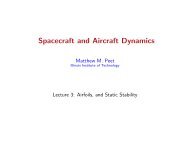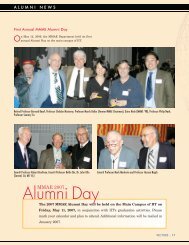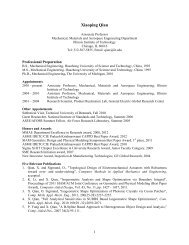Spacecraft and Aircraft Dynamics - Illinois Institute of Technology
Spacecraft and Aircraft Dynamics - Illinois Institute of Technology
Spacecraft and Aircraft Dynamics - Illinois Institute of Technology
You also want an ePaper? Increase the reach of your titles
YUMPU automatically turns print PDFs into web optimized ePapers that Google loves.
<strong>Spacecraft</strong> <strong>and</strong> <strong>Aircraft</strong> <strong>Dynamics</strong>Matthew M. Peet<strong>Illinois</strong> <strong>Institute</strong> <strong>of</strong> <strong>Technology</strong>Lecture 11: The Effect <strong>of</strong> a Non-Spherical Earth
IntroductionIn this Lecture, you will learn:The Non-Spherical Earth• The gravitational potential• Expression in the R-T-N frame• Perturbations◮◮PeriodicSecularMission Planning• Sun-Synchronous Orbits• Frozen Orbits• Critical InclinationM. Peet Lecture 11: <strong>Spacecraft</strong> <strong>Dynamics</strong> 2 / 33
Recall The Perturbation Equations⃗F disturbance = Rê R + T ê T + Nê NSemi-major AxisEccentricity:√ȧ = 2a 3µ(1 − e 2 [eR sin f + T (1 + e cos f)])tan E ecc=2Inclination:√ddt i = a(1 − e 2 ) N cos(ω + f)µ 1 + e cos fArgument <strong>of</strong> Perigee:˙ω = − ˙Ω cos i +RAAN:√a(1 − e˙Ω =2 )µ√(a(1 − e 2 )e 2 −R cos f + Tµ√1 − e1 + e tan f 2N sin(ω + f)sin i(1 + e cos f))(2 + e cos f) sin f1 + e cos fM. Peet Lecture 11: <strong>Spacecraft</strong> <strong>Dynamics</strong> 3 / 33
RecallSatellite-Normal Coordinate System⃗F = Nê N + Rê R + T ê TSatellite-Normal CS (R-T-N):• ê R points along the earth →satellite vector.• ê N points in the direction <strong>of</strong> ⃗ h• ê T is defined by the RHR◮ êT · v > 0.M. Peet Lecture 11: <strong>Spacecraft</strong> <strong>Dynamics</strong> 4 / 33
The Non-spherical EarthThe Spherical EarthRecall that gravity for a point mass isGravity force derives from the potentialfield.⃗F = ∇UTo find U, we integratedU = − 2πR2 Gσm 2 sin θdθρFor a uniform spherical mass,⃗F = −µ⃗r‖⃗r‖ 2• There is symmetry about the line ⃗r 12 .• The point-mass approximation holds.M. Peet Lecture 11: <strong>Spacecraft</strong> <strong>Dynamics</strong> 5 / 33
The Non-spherical EarthA Distorted Potential FieldFor a spherical earth, dU is symmetricdU = − 2πR2 Gσm 2 sin θdθρThe actual gravity field• Is not precisely spherical.• ρ varies throughout the object.The result is a distorted potential field.Figure: The geoid, 15000:1 scaleM. Peet Lecture 11: <strong>Spacecraft</strong> <strong>Dynamics</strong> 6 / 33
The Non-spherical EarthA Distorted Potential FieldSocrates: So how do we derive the potential field?Tycho Brahe: We measure it!!!Definition 1.Physical Geodesy is the study <strong>of</strong> thegravitational potential field <strong>of</strong> the earth.Definition 2.The Geoid is equipotential surfacewhich coincides with the surface <strong>of</strong> theocean.M. Peet Lecture 11: <strong>Spacecraft</strong> <strong>Dynamics</strong> 7 / 33
The Non-spherical EarthA Distorted Potential FieldQuestion: So how do we measure the potential field <strong>of</strong> the earth?LAGEOS: Laser Geodynamics Satellites1. Precisely measure the orbit <strong>of</strong> asatellite as it orbits the earth2. Account for drag, third-bodydynamics, etc.3. Remaining perturbation must becauses by gravitational potentialThe orbits <strong>of</strong> the LAGEOS satellites aremeasured precisely by laser reflection.Note: Only measures potential alongpath <strong>of</strong> the orbit.• We must observe for a long time toget comprehensive data.M. Peet Lecture 11: <strong>Spacecraft</strong> <strong>Dynamics</strong> 8 / 33
The Non-spherical EarthMeasuring satellite positions from earth is inaccurate.• Atmospheric DistortionGRACE:1. Measure the relative position <strong>of</strong>two adjacent satellites2. Relative motion yields gradient <strong>of</strong>the potential fieldLess fancy methods:• Survey markers• Altimetry• Ocean level variationM. Peet Lecture 11: <strong>Spacecraft</strong> <strong>Dynamics</strong> 9 / 33
The Non-spherical EarthQuestion: So what is U(⃗r)?Response: Too much data to write as a function.In order to be useful, we match the data to a few basis functions.Coordinates: Express position usingφ gc , λ, r.• φ gc is declination from equatorialplane.• r is radius• λ is right ascension, measuredfrom Greenwich meridian.We will have a function <strong>of</strong> formU(φ gc , λ, r)M. Peet Lecture 11: <strong>Spacecraft</strong> <strong>Dynamics</strong> 10 / 33
The HarmonicsThe potential has the formU(φ gc , λ, r) = µ r + U zonal(r, φ gc )+ U sectorial (r, λ)+ U tesseral (r, φ gc , λ)Actually, U sectorial varies with φ gc , but not very actively.M. Peet Lecture 11: <strong>Spacecraft</strong> <strong>Dynamics</strong> 11 / 33
The Zonal HarmonicsZonal Harmonics: These have the formU zonal (r, φ gc ) = µ ∞∑( ) i ReJ i P i (φ gc )r ri=2• R e is the earth radius• P i are the Legendre Polynomials• The J i are determined by the Geodesy data!Zonal harmonics vary only with latitude.M. Peet Lecture 11: <strong>Spacecraft</strong> <strong>Dynamics</strong> 12 / 33
The Sectorial HarmonicsSectorial Harmonics: These have the formU sect (r, φ gc , λ) = µ ∞∑(C i,sect cos(iλ) + S i,sect sin(iλ))ri=2(Rer) icos(φ gc ) i• Divides globe into slices by longitude.• Varies with φ gc , but P i,i (φ gc ) is uniformly positive.• The C i,sectorial <strong>and</strong> S i,sectorial are also determined by the Geodesy data!Sectorial harmonics vary only with longitude.M. Peet Lecture 11: <strong>Spacecraft</strong> <strong>Dynamics</strong> 13 / 33
The Tesseral HarmonicsThese have the formU tesseral (r, φ gc , λ) = µ r∞∑(C i,j cos(iλ) + S i,j sin(iλ))i,j=2(Rer) iP i,j (φ gc )• Divides globe into slices by longitude <strong>and</strong> latitude.• The C i,j <strong>and</strong> S i,j are also determined by the Geodesy data!M. Peet Lecture 11: <strong>Spacecraft</strong> <strong>Dynamics</strong> 14 / 33
The J2 PerturbationFor simplicity, we ignore all harmonics except the first zonal harmonic.(Re) 2 [ 32 sin2 (φ gc ) − 1 2]∆U J2 (r, φ gc ) = µ r (J 2rThis corresponds to a single b<strong>and</strong> about theequator.• The earth is 21 km wider than it is tall.• A flattening ratio <strong>of</strong>1300 .• J 2 = .0010826• J 3 = .000002532• J 4 = .000001620M. Peet Lecture 11: <strong>Spacecraft</strong> <strong>Dynamics</strong> 15 / 33
The J2 PerturbationSince sin φ gc = z r ,U J2 (r, φ gc ) = µ rJ 22(ReWe now calculate the perturbation force as⃗F = ∂U J2∂r= µJ 2 R 2 eêR + ∂U J2[∂z3zr 5 êz +From the rotation matrices, we have that<strong>and</strong> sinceêzr) 2 [ 3z2r 2 − 1 ]( ) ]32r 4 − 15z22r 6 ê Rê z = sin i sin(ω + f)ê R + sin i cos(ω + f)ê T + cos iê Nz = r sin φ gc = r sin i sin(ω + f)Using θ = ω + f, this yields the disturbing force in the R-T-N frame:⃗F = −3µJ 2Re2 [( 1r 4 2 − 3 sin2 i sin 2 ) ]θê R + sin 2 i sin θ cos θê T + sin i sin θ cos iê N2M. Peet Lecture 11: <strong>Spacecraft</strong> <strong>Dynamics</strong> 16 / 33
The J2 PerturbationThe primary effect <strong>of</strong> J 2 is on Ω <strong>and</strong> ω.We plug the force equations into the expressions for ˙Ω <strong>and</strong> ˙ω√a(1 − e˙Ω =2 ) N sin(ω + f)µ sin i(1 + e cos f)to get˙Ω = − 3µJ 2R 2 ehp 3 cos i sin 2 θ [1 + e cos f] 3If we average ˙Ω over an orbit, then we get the final expression˙Ω J2,av = − 3 ( ) 22 nJ Re2 cos ipLikewise, we can find an expression for ˙ω:˙ω J2,av = 3 2 nJ 2(Rep) 2 [2 − 5 ]2 sin2 iM. Peet Lecture 11: <strong>Spacecraft</strong> <strong>Dynamics</strong> 17 / 33
J2 Nodal RegressionPhysical ExplanationThe ascending node migrates opposite the direction <strong>of</strong> flight˙Ω J2,av = − 3 ( ) 22 nJ Re2 cos ipThe equatorial bulge produces extra pullin the equatorial plane• Creates a torque on the angularmomentum vector• Like gravity, the torque causes ⃗ h toprecess.• Only depends on inclinationM. Peet Lecture 11: <strong>Spacecraft</strong> <strong>Dynamics</strong> 18 / 33
J2 Nodal RegressionMagnitudeThe nodal regression rate is <strong>of</strong>ten large. Cannot Be Neglected!!!.Figure: Magnitude <strong>of</strong> Regression Rate vs. inclination <strong>and</strong> altitudeM. Peet Lecture 11: <strong>Spacecraft</strong> <strong>Dynamics</strong> 19 / 33
J2 Apsidal RotationSimilar to nodal regression, but perigee moves forward or backward, dependingon inclination.˙ω J2,av = 3 ( ) 2 [2 nJ Re2 2 − 5 ]p 2 sin2 iM. Peet Lecture 11: <strong>Spacecraft</strong> <strong>Dynamics</strong> 20 / 33
J2 Apsidal RotationMagnitudeThe apsidal rotation rate is <strong>of</strong>ten large.Figure: Magnitude <strong>of</strong> Regression Rate vs. inclination <strong>and</strong> altitudeM. Peet Lecture 11: <strong>Spacecraft</strong> <strong>Dynamics</strong> 21 / 33
J2 EffectOther Elements: EccentricityThe J 2 effect on other elements is usually minor. ȧ ∼ = 0.Figure: Eccentricity Change for Low-Inclination OrbitM. Peet Lecture 11: <strong>Spacecraft</strong> <strong>Dynamics</strong> 22 / 33
J2 EffectOther Elements: EccentricityFigure: Eccentricity Change for Moderate-Inclination OrbitM. Peet Lecture 11: <strong>Spacecraft</strong> <strong>Dynamics</strong> 23 / 33
J2 EffectOther Elements: EccentricityFigure: Eccentricity Change for High-Inclination OrbitM. Peet Lecture 11: <strong>Spacecraft</strong> <strong>Dynamics</strong> 24 / 33
J2 EffectOther Elements: InclinationFigure: Inclination Change for Eccentric <strong>and</strong> Circular OrbitsM. Peet Lecture 11: <strong>Spacecraft</strong> <strong>Dynamics</strong> 25 / 33
J 2 Special OrbitsCritical InclinationDefinition 3.˙ω J2,av = 3 2 nJ 2(ReA Critically Inclined Orbit is one where ˙ω = 0For a critically inclined orbit,which means4 − 5 sin 2 i = 0i = sin −1 √ 4/5= 63.43 ◦ or 116.57 ◦p) 2 [2 − 5 ]2 sin2 iM. Peet Lecture 11: <strong>Spacecraft</strong> <strong>Dynamics</strong> 26 / 33
J 2 Special OrbitsSun-Synchronous OrbitsSun-Synchronous orbits maintain the same orientation <strong>of</strong> the orbital plane withrespect to the sun.Applications:• Mapping• Solar-Powered• Shadow-evading• Time-<strong>of</strong>-Day AppsM. Peet Lecture 11: <strong>Spacecraft</strong> <strong>Dynamics</strong> 27 / 33
J 2 Special OrbitsSun-Synchronous OrbitsThe earth rotates 360 ◦ about the sun every 365.25 days.Definition 4.A Sun-Synchronous Orbit is one where ˙Ω = .9855 ◦ /day = 1.992 · 10 −7 rad/s.Thuscos i = −1.992 · 10 −7 ( pR e) 223nJ 2• The orbital plane rotates onceevery year.M. Peet Lecture 11: <strong>Spacecraft</strong> <strong>Dynamics</strong> 28 / 33
J 2 Special OrbitsSun-Synchronous OrbitsUnlike critically inclined orbits, sun-synchronous orbits depend on altitude.M. Peet Lecture 11: <strong>Spacecraft</strong> <strong>Dynamics</strong> 29 / 33
Numerical ExampleL<strong>and</strong>satProblem: Design a sun-synchronous orbit with r p = R e + 695km <strong>and</strong>r a = R e + 705km.Solution: The desired inclination for a sun-synchronous orbit is given by(( ) )2 pi = cos −1 −4.778 · 10 −6 2R e 3nJ 2For this orbit a = R e + 700km = 7078km. The eccentricity ise = 1 − r pa ∼ = 0J 2 = .0010826. Thus the required inclination isi = 1.716rad = 98.33 ◦M. Peet Lecture 11: <strong>Spacecraft</strong> <strong>Dynamics</strong> 30 / 33
Numerical ExampleMolnaya OrbitProblem: Molnaya Orbits are usually designed so that perigee always occursover the same latitude. Design a critically inclined orbit with a period <strong>of</strong> 12hours <strong>and</strong> which precesses at ˙Ω = −.2 ◦ /day .Solution: We can first use the period to solve for a. From<strong>and</strong> n = 2π/T = 2rad/day we haven =√ µa 3a = 3 √ µn 2Now the critical inclination for ˙ω = 0 is i = 63.4 ◦ or i = 116.6 ◦ . We choosei = 63.4 ◦ . To achieve ˙Ω = −.2 ◦ /day, we use˙Ω = −3nJ 2Re22a 2 (1 − e 2 ) 2 cos iM. Peet Lecture 11: <strong>Spacecraft</strong> <strong>Dynamics</strong> 31 / 33
Numerical ExampleMolnaya Orbit, continuedSince a is already fixed, we must use e. We can solve for e as√e = 1 +√− 3nJ 2Re22 ˙Ωacos i = .7459.2Note: Make sure the units <strong>of</strong> a <strong>and</strong> n match those <strong>of</strong> R e <strong>and</strong> ˙Ω, respectively.M. Peet Lecture 11: <strong>Spacecraft</strong> <strong>Dynamics</strong> 32 / 33
SummaryThis Lecture you have learned:How to account for perturbations to Earth gravity• Gravity Mapping• Harmonic Functions• J 2 Perturbation◮ Effect on Ω◮ Effect on ω◮ Minor effect (e, i)How to design specialized orbits• Critically - Inclined Orbit.• Sun-Synchronous Orbit.• ApplicationsNext Lecture: Final Review.M. Peet Lecture 11: <strong>Spacecraft</strong> <strong>Dynamics</strong> 33 / 33


